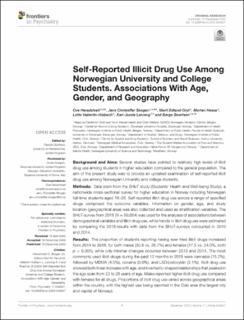| dc.description.abstract | Background and Aims: Several studies have pointed to relatively high levels of illicit drug use among students in higher education compared to the general population. The aim of the present study was to provide an updated examination of self-reported illicit drug use among Norwegian University and college students.
Methods: Data stem from the SHoT study (Students' Health and Well-being Study), a nationwide cross-sectional survey for higher education in Norway including Norwegian full-time students aged 18–35. Self-reported illicit drug use across a range of specified drugs comprised the outcome variables. Information on gender, age, and study location (geographical area) was also collected and used as stratification variables. The SHoT-survey from 2018 (N = 50,054) was used for the analyses of associations between demographical variables and illicit drug use, while trends in illicit drug use were estimated by comparing the 2018-results with data from the SHoT-surveys conducted in 2010 and 2014.
Results: The proportion of students reporting having ever tried illicit drugs increased from 2014 to 2018, for both males (30.8 vs. 36.7%) and females (17.5 vs. 24.0%, both p < 0.001), while only minimal changes occurred between 2010 and 2014. The most commonly used illicit drugs during the past 12 months in 2018 were cannabis (15.2%), followed by MDMA (4.0%), cocaine (3.0%), and LSD/psilocybin (2.1%). Illicit drug use showed both linear increase with age, and inverted U-shaped relationships that peaked in the age span from 23 to 28 years of age. Males reported higher illicit drug use compared with females for all drugs. Proportions of illicit drug use varied across geographical areas within the country, with the highest use being reported in the Oslo area (the largest city and capital of Norway).
Conclusions: The present study reports an increase from 2010 to 2018 among Norwegian University and college students in the proportion of those reporting to have tried illicit drugs. Despite varying proportions of use across type of drug, age, gender, and geographical location, the overall high levels of illicit drug use past 12 months confirm the need to address illicit drug use in this population. | en_US |

